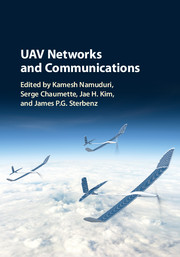Book contents
- Frontmatter
- Dedication
- Contents
- Preface
- Contributors
- 1 Introduction to UAV Systems
- 2 Air-to-Ground and Air-to-Air Data Link Communication
- 3 Aerial Wi-Fi Networks
- 4 Disruption-Tolerant Airborne Networks and Protocols
- 5 UAV Systems and Networks: Emulation and Field Demonstration
- 6 Integrating UAS into the NAS – Regulatory, Technical, and Research Challenges
- 7 Safety, Security, and Privacy Aspects in UAV Networks
- 8 Collaboration Between Autonomous Drones and Swarming
- 9 Real-World Applications
- References
- Index
Preface
Published online by Cambridge University Press: 17 November 2017
- Frontmatter
- Dedication
- Contents
- Preface
- Contributors
- 1 Introduction to UAV Systems
- 2 Air-to-Ground and Air-to-Air Data Link Communication
- 3 Aerial Wi-Fi Networks
- 4 Disruption-Tolerant Airborne Networks and Protocols
- 5 UAV Systems and Networks: Emulation and Field Demonstration
- 6 Integrating UAS into the NAS – Regulatory, Technical, and Research Challenges
- 7 Safety, Security, and Privacy Aspects in UAV Networks
- 8 Collaboration Between Autonomous Drones and Swarming
- 9 Real-World Applications
- References
- Index
Summary
Aviation authorities around the world have been making progress towards integrating UAVs (unmanned aerial vehicles) into their national airspaces. In parallel, private industry has been developing innovative UAV-based applications, such as drone-based package delivery, medicine delivery, pipeline monitoring systems, and disaster-area aerial surveys. However, before UAVs can become integrated into the civilian airspace and such real-world applications become reality, there are several technical, societal, and regulatory challenges that need to be addressed by the research community. The most important among them is the need for enhanced situational awareness of UAVs in the airspace.
Three different, yet complementary, paradigms emerged to address enhanced situational awareness of UAVs: satellite communications, cellular-communications, and aerial communications and networks. This book focuses on the third strategy, i.e., enhanced situational awareness through self-organized aerial networking of UAVs. It provides the necessary knowledge for students, researchers, and professionals to gain an understanding of the research challenges in UAV networks and communications. Collaborating with several eminent research scholars and subject matter experts, the editors developed nine chapters that take the reader from the foundations to active research topics in this exciting domain.
The first chapter, “Introduction to UAV Systems,” introduces the reader to UAV types and missions. It provides the background and context for UAVs and UAV networks with a focus on their civilian applications. It also discusses the state-of-the-art in engineering and technology aspects of UAV networks and the benefits of deploying such networks.
The second chapter, “Air-to-Ground and Air-to-Air Data Link Communication,” provides the background on wireless communication used in manned aviation. It discusses the technologies proposed for L-band Digital Aeronautical Communication. It provides the fundamental insights relevant for aerial communication on unmanned and small UAVs, learned from experience with the advanced terrestrial mobile broadband communication extrapolated to the aerial case.
The third chapter, “AerialWi-Fi Networks,” provides the characteristics of aerial links in three-dimensional space (3D). Aerial networks differ from other wireless networks, such as mobile ad hoc networks or vehicular ad hoc networks. It discusses the communication requirements for aerial network applications in terms of throughput, delay, data exchange frequency, etc. It defines different levels of autonomy in aerial networks from the perspective of communication needs.
- Type
- Chapter
- Information
- UAV Networks and Communications , pp. xiii - xivPublisher: Cambridge University PressPrint publication year: 2017



